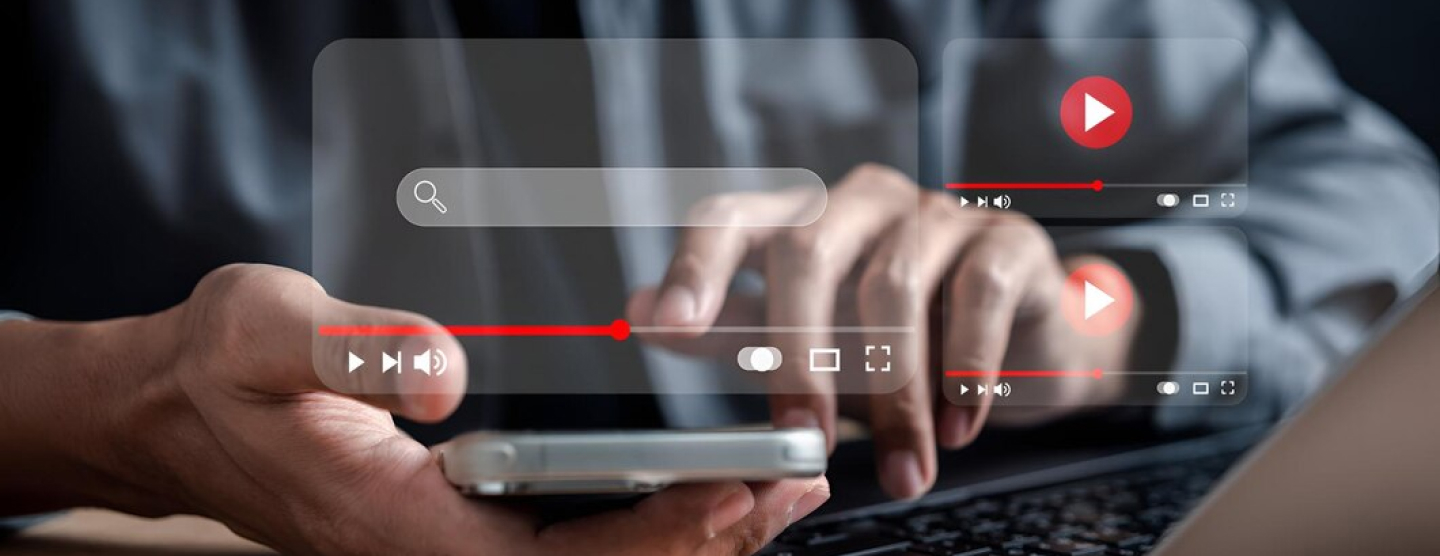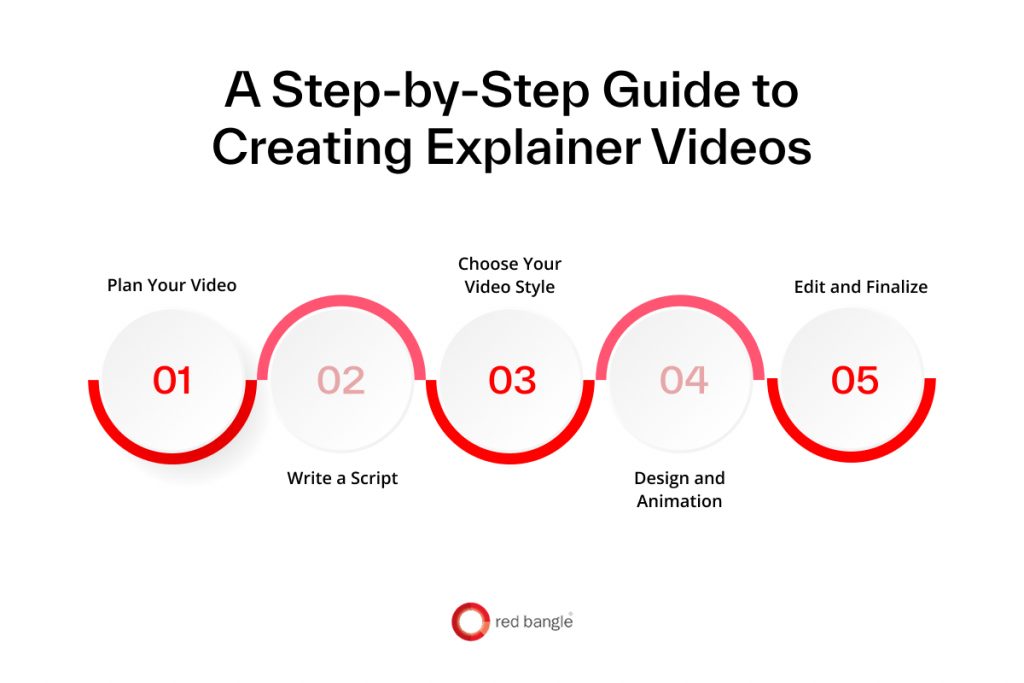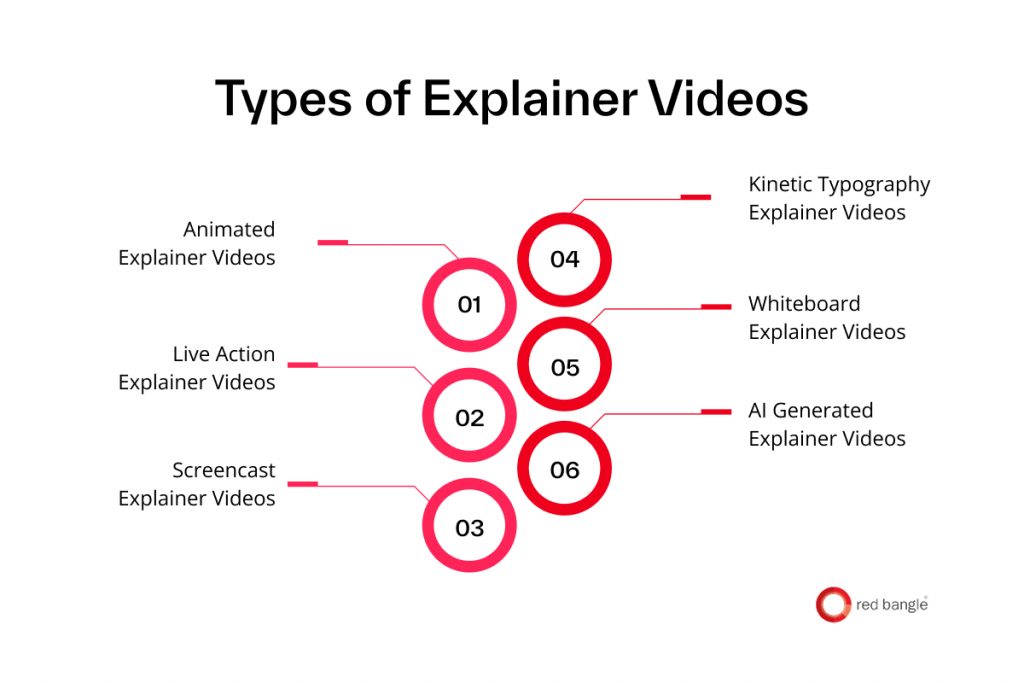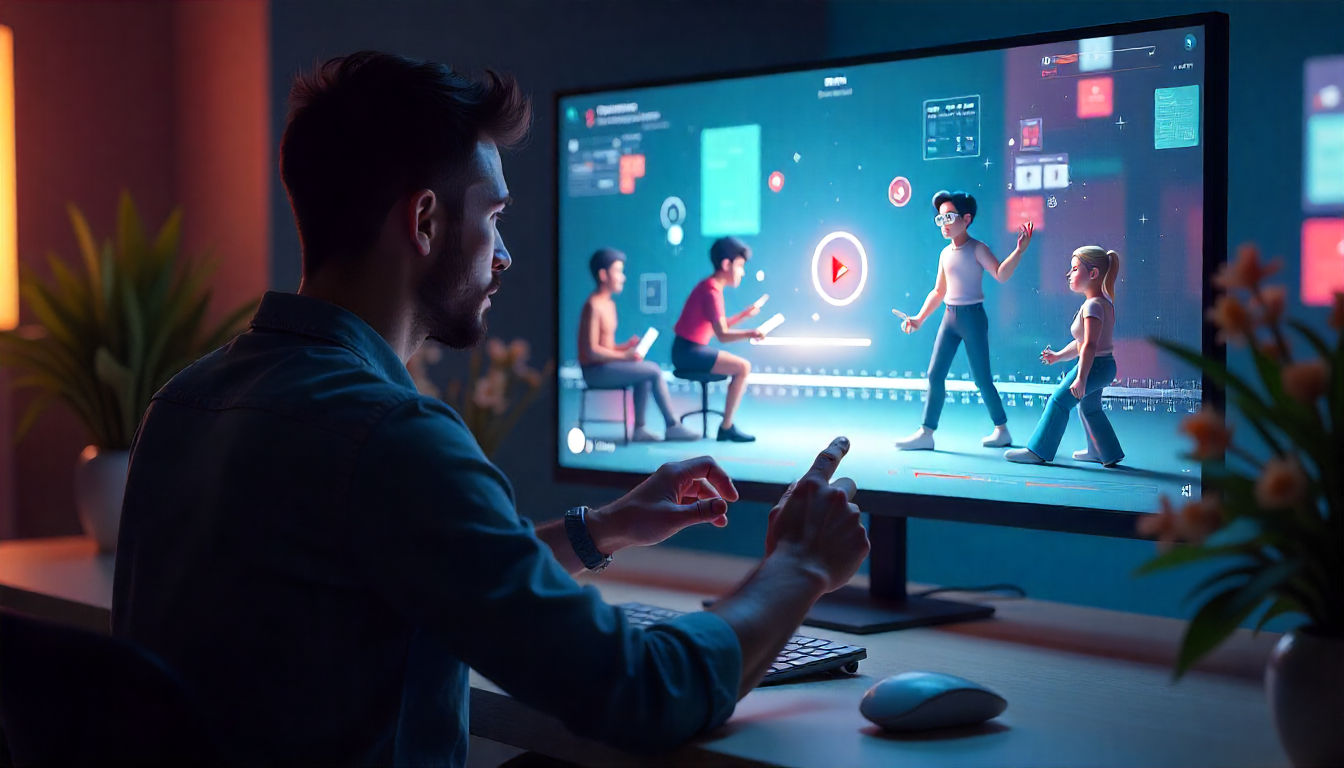A Comprehensive Guide to Creating Explainer Videos in 2025
Learn how to create compelling explainer videos that simplify complex ideas, drive engagement, and boost conversions. Discover step-by-step guidance on planning, scripting, choosing styles, and best practices to craft videos that resonate with your audience and enhance your marketing strategy.

Introduction
Your product is solid, but your pitch is not landing. Your email explains too little. The demo explains too much, and your landing page is still bleeding traffic. You’ve got seconds to make someone “get it,” and you’re burning through them with complicated copy that doesn’t convert and sales decks no one finishes.
You’ve got the right product, the right audience, even the right intent. But somehow, your message still doesn’t land. Sometimes, words aren’t just enough. But what words fail to say, visuals explain. They don’t just tell. They show, simplify, and stick within 90 seconds or less, just enough for your audience’s limited attention span.
That’s why 51% of marketers already use videos. 90% say video brings positive ROI, the best-performing content format today, compared to content. So if your message is falling flat and your funnel feels stuck, this guide is your fix.
In this blog, we’ll explain how to create explainer videos, types of explainer videos, and best practices to create high-converting videos for your brand.
How to Create Explainer Videos: A Step-by-Step Guide
Explainer videos are an excellent way to communicate complex ideas quickly, making them an indispensable tool in a brand’s marketing arsenal.

Here’s a comprehensive breakdown of the process to create effective explainer videos:
Step 1: Plan Your Video
Planning is the foundation of any successful explainer video. Before diving into production, it’s crucial to define the video’s purpose and structure. Start by asking the following questions:
- What is the objective of the video? Is it to drive conversions, explain a service, or build brand awareness?
- Who is your target audience? Tailor your content, tone, and visuals to meet the specific needs of your viewers.
- What is your key message? Focus on delivering one core message that resonates with your audience.
- When should you use an explainer video? You can use explainer videos at TOFU to generate curiosity, at MOFU for education, and at BOFU to drive conversions.
- Where should your explainer videos appear? Demos or outbound campaigns? Ad landing pages?
- How should you approach creating these videos? Experiment with DIY tools or hire a professional video production agency?
Create a solid brief that answers the 6Ws (What, Why, Who, Where, When, and How). Our blog on The 6Ws of a Good Video Brief is a great resource to structure your thinking before you dive deep into production. Once these factors are clear, create a project brief that outlines key points, the desired tone, visual style, and video length. This brief will serve as your roadmap for the next steps.
At Red Bangle, we start with a discovery session to align with our client’s objective, whether it’s driving demos, simplifying onboarding, or boosting product adoption. These sessions help us understand exactly what the client is aiming for, so we can recommend the right video strategy, not as an outsourced vendor, but as a creative partner. We use this time to walk clients through case studies, best practices, and what’s worked before, tailored to their specific goals.
Step 2: Write a Script
The script is the backbone of your explainer video. It’s where you structure your message, so clarity is paramount. Here’s how to approach it:
- Keep it concise: The ideal explainer video is 60 to 90 seconds long, translating to roughly 150-250 words. In this short time, you need to deliver a clear, engaging message.
- Structure your script: A good explainer video follows a simple structure:
- Hook: Grab attention immediately (e.g., highlight the problem your audience faces).
- Solution: Show how your product or service solves the problem.
- Call to Action (CTA): Prompt the viewer to take the next step (e.g., sign up, book a demo, etc.).
- Make it relatable: Avoid jargon and keep the language simple. Speak to your audience’s pain points and show them how your solution makes their lives easier.
At Red Bangle, scripting is a collaborative, strategy-first process. Take our interactive explainer for SLB on sales digitization, for example. We worked closely with SLB’s team to break down complex ideas into an engaging, interactive experience, keeping viewers actively involved. The interactive format allowed viewers to explore and engage with the content, ensuring they stayed immersed in the message. The format kept the content sharp, clear, and on-brand, delivering a dynamic and impactful experience that maintained strong engagement from start to finish.
Step 3: Choose Your Video Style
The style of your explainer video shapes how well your message lands. At Red Bangle, we don’t pick a format just because it looks good. We match it to the business goal.
“Clients walk away from our first meeting with two or three creative options, complete with timelines and pricing, equipped to make the best decision for their business. All before they’ve even signed a contract” – Lakshmi Rebecca, Founder, Red Bangle
Whether it’s simplifying a complex SaaS product or humanizing a B2B service, we recommend styles based on what drives clarity and conversion. For Example:
1. Animated Explainers:
These are great for simplifying complex ideas through fun, engaging visuals. They’re flexible, highly creative, and perfect for abstract concepts.
Take our Explainer Campaign with Multiplier, for example. Multiplier wanted to simplify hiring compliance for a global audience, and clarity was non-negotiable. Explaining compliance and cross-border payroll isn’t exactly thrilling. But we crafted an animated explainer that distilled complex workflows like payroll, legal nuances, and local regulations into a sharp, intuitive narrative.
This campaign helped launch Multiplier’s solution globally and supported their lead acquisition goals.
2. Live-Action Explainers:
Ideal for building trust and credibility, especially when you want to show real people using your product or service.
A strong example is our live-action campaign with Vymo for Salesforce. Sales workflows can be hard to visualize. So, instead of explaining features, we followed a rep’s real day, showing how Vymo’s real-time nudges, reminders, and updates simplify daily sales ops and keep teams in sync. The tone was intentionally light and relatable, making an otherwise complex product feel effortless. The video helped Vymo communicate product value with clarity and saw a measurable lift in demo requests.
3. Screencast Explainers:
Best suited for software demonstrations or technical tutorials. A simple screen recording with voiceover can walk the audience through your product’s features and functionality.
“We help clients choose not just what looks good, but what works. Top-of-funnel videos may demand polish and presence. Mid-funnel can be leaner, and bottom-funnel might just need a scrappy demo or screen recording. Each has its place” – Lakshmi Rebecca, Founder, Red Bangle
For example, we created a screencast explainer for Infosys Equinox Studio, a sleek, action-driven video that delivers a first-hand experience of the solution, showing exactly how the platform works in real-time. This type of explainer is particularly effective in providing viewers with direct insight into a product, ensuring they grasp its functionality quickly and easily.
Choosing the right style depends on your message, target audience, and brand image. For example, a tech company explaining a complex process might opt for an animated explainer, while a fitness brand could benefit more from a live-action explainer that shows real people in action.
Step 4: Design and Animation
This is where your video starts to take shape visually. The design and animation phase includes:
- Visual Elements: Create characters, backgrounds, and objects that align with your brand identity. Keep the visuals simple, clean, and relevant to your message.
- Animation Techniques: Choose your animation style (2D, 3D, motion graphics) based on your goals. If you’re creating a light-hearted, creative video, 2D animation might be ideal. For a more polished look, 3D animation or motion graphics might work better.
- Timing and Transitions: Ensure smooth transitions between scenes and sync animation with the script for a seamless viewing experience. The pacing should match the flow of the script.
A great example of how we bring animation and storytelling together is showcased in our recent project on AI Explainer Videos, where we explored how to visualize abstract, evolving concepts like AI tools and workflows. From visual metaphors to motion-led transitions, every design decision supported clarity and narrative flow.
Also read → AI Explainer Videos: Tools and Trends that Brand Teams Can’t Ignore.
Step 5: Edit and Finalize
The final step is editing your video to ensure everything flows smoothly. During this stage:
- Pacing: Adjust the video length by trimming unnecessary content and improving transitions. Ensure the video stays within the 60-90 second range for maximum engagement.
- Voiceover: Choose a voice that matches your brand tone, whether friendly, professional, or playful. The voiceover should be clear and energetic to keep viewers engaged.
- Sound Design: Add background music and sound effects to complement the visuals, but avoid overwhelming the voiceover. Music should enhance the mood, not distract from the message.
By using the right style and storytelling techniques, you can create compelling explainer videos that not only engages your audience but also converts them into loyal customers.
Whether you choose to do it yourself with DIY tools or hire a professional agency like Red Bangle, an explainer video is an investment that can significantly boost your marketing efforts.
Types of Explainer Videos
Explainer videos are short, engaging videos that clearly explain a product, service, or concept through visual story telling. They combine visuals, voiceover, and storytelling to simplify complex information in 60 to 90 seconds. Businesses use explainer videos on websites, social media, and sales presentations to increase conversions, improve understanding, and reduce bounce rates.
Explainer videos come in various formats, each with its unique advantages. Choosing the right type depends on your message, target audience, and overall marketing strategy. Here’s a breakdown of the most common types of explainer videos:

1. Animated Explainer Videos
Animated explainer videos are popular due to their versatility and creativity. They allow you to visually simplify complex ideas and abstract concepts, making them easy to understand. They are one of the smartest ways to simplify, sell, and stand out.
- Best for: Complex products or services, SaaS companies, startups.
- Pros: Easy to create, highly customizable, great for illustrating intangible concepts.
- Example: Dropbox animated video explains the cloud storage service, breaking down a complex concept into easy-to-understand visuals.
- Why it works: Animation can make any abstract concept feel accessible. It’s fun, engaging, and allows for a level of creativity that live-action videos simply can’t match.
Red Bangle’s animation expertise is trusted by brands looking to translate complexity into clarity. Be it a 60-second SaaS explainer like Multiplier or Adobe’s interactive campaign, we’ve created animated videos that inform, engage, and convert. Our work with brands like Infosys, Wipro, Adobe, & Vymo are a few examples where animation became the bridge between product depth and viewer simplicity.
2. Live Action Explainer Videos
Live-action explainer videos use real people and settings to convey the message. They are ideal for building a personal connection and trust with your audience.
- Best for: Customer testimonials, product demonstrations, service-based businesses.
- Pros: Builds trust, emotional connection, credibility.
- Example: A fitness brand uses live-action to show real people working out and achieving their goals, creating an emotional connection with the audience.
- Why it works: It humanizes the brand and connects with viewers on a deeper, emotional level. People trust other people, which is why live-action explainer videos work well for building credibility and authenticity. According to a Hubspot Survey, 62% of consumers preferred to watch videos (for product demos, FAQs, reviews etc)
At Red Bangle, we create campaign-style explainer videos that feel less like ads and more like real stories. A recent live-action demo for Vymo, for example. The narrative was crafted to reflect the everyday reality of a sales rep’s life, with a relatable tone and upbeat storytelling that ultimately helped drive demo conversions.
3. Screencast Explainer Videos
Screencast explainer videos capture the screen and can show your software or product in action. This type is ideal for demonstrating features or tutorials.
- Best for: Software products, tech tutorials, SaaS platforms.
- Pros: Direct, easy to produce, great for technical audiences.
- Example: A software company might use a screencast video to show how to navigate its interface and use its features.
- Why it works: It’s straightforward and clear, allowing viewers to learn by seeing the product in action.
4. Kinetic Typography Explainer Videos
Kinetic typography videos use animated text and moving visuals to communicate a message. These videos are dynamic and engaging, relying heavily on the power of text and motion to convey ideas.
- Best for: Explaining concepts with strong messaging, product highlights, or emotional appeal.
- Pros: High energy, grabs attention, and works well for quick, impactful explanations.
- Example: A product demo or service explanation can use kinetic typography to emphasize key features or stats in an engaging, visually-driven way.
- Why it works: The animated text helps maintain viewer engagement, while delivering clear and memorable messages, making it ideal for explainer videos that require fast, focused communication.
5. Whiteboard Explainer Videos
Whiteboard explainer videos show the process of drawing out key concepts on a whiteboard. This format has a casual, educational feel and helps break down complex ideas step by step.
- Best for: Educational content, process breakdowns, concepts that need simplification.
- Pros: Simple, engaging, easy to follow.
- Example: Educational websites or training companies often use whiteboard videos to explain processes or theories in a visually appealing way.
- Why it works: The step-by-step drawing makes it easy for viewers to understand complicated information. This type of explainer video also keeps things visually interesting without overwhelming the audience.
Whiteboard videos don’t have to be slow or old-school. We proved it with Adobe’s in-store explainer campaign. Quick, witty sketches broke down Creative Cloud for walk-in customers, making a complex product instantly relatable. That’s the power of whiteboard explainers. They simplify complex ideas without dumbing down and are perfect for process walkthroughs, onboarding, or feature demos.
At Red Bangle, we use this style when the brief calls for clarity with character and when we want viewers to say “Got it!” in under 60 seconds.
6. AI Generated Explainer Videos
AI-generated explainer videos are a newer concept, using artificial intelligence tools to automate video creation. These videos leverage machine learning and AI algorithms to generate animations, voiceovers, and even scriptwriting.
- Best for: Companies looking to scale video content production quickly and affordably.
- Pros: Fast, cost-effective, customizable.
- Example: AI-driven tools like Synthesia use AI to generate explainer videos with avatars and voiceovers, making it easy for brands to produce high-quality content at scale.
- Why it works: AI-generated explainer videos are ideal for brands that need a high volume of content quickly without sacrificing quality. The ability to generate scripts, animations, and voiceovers using AI makes them a flexible solution for modern marketing strategies.
| Video Type | Best For | Key Advantage | When to Choose |
| Animated Explainer Videos | Explaining complex services or abstract ideas | Flexibility in visual storytelling; high customization | When you need to break down complex concepts visually |
| Live Action Explainer Videos | Building trust with real-life scenarios | Personal touch, real human connection | For showcasing product demos, customer stories, or testimonials |
| Screencast Explainer Videos | Demonstrating software, tutorials, or features | Clear, direct demonstrations with no distractions | Ideal for tech products or any “how-to” content |
| Kinetic Typography Explainer Videos | Conveying strong, quick messages | High-energy, visually engaging text-based storytelling | For impactful, concise messaging, especially in campaigns |
| Whiteboard Explainer Videos | Educational content, step-by-step breakdowns | Simple, visual method for explaining processes | When you want a casual, educational, process-driven explanation |
| AI-Generated Explainer Videos | Scalable, cost-effective video production | Speed and affordability without compromising quality | When needing high-volume content quickly with a polished look |
Each type of explainer video serves a unique purpose depending on the needs of the brand and the message it wants to convey. Whether you choose animation, live action, or AI-generated videos, it’s important to align the video format with your overall marketing strategy and audience preferences.
DIY Explainer Videos vs Professional Video Production Agencies: What to Choose?
The choice between DIY and hiring a professional agency can significantly impact the outcome.
Here’s a quick breakdown of the pros and cons of each option:
Pros and Cons between DIY Explainer Videos & Professional Video Production Agency
| Aspect | DIY Explainer Videos | Professional Video Production |
| Cost | Low. You can use affordable tools and platforms. | High. More investment in quality and expertise, resulting in higher chances of conversion |
| Control | Full control over script, style, and pacing. | Guided by professionals & best practices adding value to your positioning |
| Quality | Quality varies based on skill and tools used. | High quality, polished, and professional output. |
| Time Investment | Can be faster, especially with simple tools. | Longer production time, but more efficient. |
| Customization | Limited by tools and your own skills. | Fully tailored to your brand’s needs and message. |
When Exactly Should You Hire a Professional Video Production Agency?
DIY videos can get the job done until they don’t. If you’re checking off any of the boxes below, it’s time to bring in the pros. Here’s when to stop hacking it in-house and start calling in expertise that moves the needle:
1. You’re Launching Something That Cannot Fall Flat
Launching a Flagship product? A high-stakes campaign? Rebranding effort? If the launch matters, visuals can’t look like a rushed Zoom recording. A professional team brings in storyboard clarity, cinematic shots, and cohesive storytelling, ensuring your first impression doesn’t become your last.
Big launches come with big expectations. You’ve got one shot to impress and a mediocre explainer just won’t cut it.
When Multiplier was ready to take their HR tech platform global, they didn’t play it safe. They teamed up with Red Bangle to create an animated explainer that broke down tricky topics like compliance, payroll, and local labor laws, all in a way that felt fresh, clear, and seriously compelling. This video campaign helped them drive global visibility and real results during launch.
2. Your Message Is Complicated (and Critical)
Are you selling a technical solution or a multi-step process? B2B SaaS, logistics platforms, and fintech products aren’t easy to explain.
Professional agencies can help distill jargon-heavy material into clear, visual messaging that sticks.
Some stories aren’t easy to tell, especially when you’re selling to niche audiences or explaining layered product features. SME Banking? Mobile-first CRM? Definitely not a love-at-first-sight. But with Vymo’s SME Banking campaign, we made it look effortless. We turned a complex CRM into a lively, relatable day-in-the-life film, packed with real-world moments, smart nudges, and the kind of clarity that slides just can’t offer. The messaging hit home, the story clicked, and most importantly, it moved the funnel.
3. You’re Speaking to High-Value External Stakeholders
You have only one shot to prove you’re legit to high-value stakeholders like Investors, Enterprise clients, or Industry analysts. A shaky video with patchy sound just doesn’t cut it. Professional production ensures trust, clarity, and polish, all critical in high-stakes conversations.
“Sometimes we’re asked to present our creative strategy not just to the marketing lead, but to their boss, their founder, their founder’s boss. We show up for those conversations too because we partner, not just pitch” – Lakshmi Rebecca, Founder, Red Bangle
4. You’re Planning a Series, Not Just One-Offs
If you’re planning high-stakes projects like email drip campaigns, product walkthroughs, FAQs, social snippets etc., consistency becomes non-negotiable. Agencies streamline production, maintain brand tone, and scale without breaking process or budget.
5. You Want More Than Just “Views”
Looking to rank on Google, improve page dwell time, or drive conversions? Professional agencies know how to optimize videos with metadata, captions, CTAs, and platform-native formatting, driving more conversions.
You don’t get second chances with first impressions. And in B2B, getting it wrong doesn’t just cost views. It costs trust, demos, and deals. You’re not investing in video for aesthetics. You’re investing in outcomes such as more demo requests, better onboarding, and shorter sales cycles. That’s why high-stakes projects deserve more than just nice visuals.
That’s why teams at SLB, Vymo, and Multiplier partnered with Red Bangle because the margin for error was zero. From enterprise explainers to product launches, we’ve helped them go from idea to impact, with videos that actually move the needle.
And here’s the part most agencies won’t tell you: Execution breaks down at scale. Missed timelines. Scattered feedback. Versions lost in inboxes. That’s where Red Bangle stands apart.
We don’t run on email threads and spreadsheets. We run on our proprietary Creative Cloud Platform, a tech backbone we built in-house to make production seamless, global collaboration effortless, and delivery lightning fast.
Think:
- Your brief. Versioned. Tracked. Always visible.
- Timelines and approvals, in one dashboard.
- Assets stored, sliced, repurposed, and never lost.
- Real-time feedback that moves the project forward.
It’s how we deliver not just one video, but a system of content, faster, smarter, and made for reuse across your funnel.
If you’re looking for more than just a vendor, someone who gets the brief, gets the business, and delivers with clarity, book a demo with us.
Best Practices to Create Explainer Videos
When it comes to creating explainer videos, there’s no one-size-fits-all. But following a few best practices can make your video more impactful and improve its performance. Here’s a list of key principles to help you create a video that engages and converts:
1. Keep It Short and Engaging
Why it matters: People have short attention spans. The best explainer videos get straight to the point, typically staying under 90 seconds. A concise, engaging video ensures the viewer stays focused on the key message, without drifting off.
How to implement it:
- Focus on one core message.
- Avoid unnecessary details and stick to what matters.
- Add elements of surprise or humor to maintain engagement.
“B2B marketers are very data-savvy. They’re constantly looking at competition, tracking performance, and proving ROI. They know what’s working and aren’t afraid to ask for shorter, sharper edits that land faster” – Lakshmi Rebecca, Founder, Red Bangle
2. Use Storytelling to Connect with Your Audience
Why it matters: Stories are naturally engaging. The best explainer videos use storytelling to build an emotional connection with the audience. By positioning your product or service as a solution to a problem, you make it more relatable and memorable.
How to implement it:
- Start with a relatable problem your audience faces.
- Introduce your product as the solution.
- End with a positive outcome, showcasing how your solution makes life easier.
3. Focus on Quality Scriptwriting
Why it matters: A well-written script will keep the video on track, making sure it’s both informative and engaging. Bad scripts can lead to confusion, leaving your audience disengaged.
How to implement it:
- Keep the script simple and clear.
- Use a conversational tone to make it feel personal.
- Follow the problem-solution-CTA structure for clarity.
4. Choose the Right Video Style
Why it matters: The style of your video influences how your message is received. Whether it’s animation, live action, or a combination of both, the right style should complement your message and audience.
How to implement it:
- Animated Explainer Videos work well for abstract concepts or when you need flexibility in design.
- Live Action Explainers are great for personal connections and building trust, especially for services and product demos.
- Kinetic Typography can be used to add a dynamic, fast-paced element for messaging that needs a punch.
5. Optimize for Different Platforms and Devices
Why it matters: Not all viewers watch videos the same way. Whether it’s on a desktop, mobile, or in autoplay mode, your video should be optimized for all screen sizes and viewing conditions.
How to implement it:
- Ensure the video works well on mobile by keeping text readable and visuals clear.
- Add captions for autoplay on social media platforms.
- Test the video in different environments to ensure it retains impact.
6. Measure and Iterate
Why it matters: Creating a video is just the beginning. To improve your content, it’s essential to track its performance, understand what works, and iterate based on feedback.
How to implement it:
- Track metrics like view count, engagement rate, and conversion rates.
- Gather audience feedback to refine future videos.
From keeping it short and engaging to ensuring clarity and alignment with your brand, following these steps will help your explainer videos resonate with your audience and deliver tangible business outcomes.
Conclusion
If there’s one shift modern marketers need to make, it’s to stop treating explainer videos like one-time assets. The real ROI happens when you treat them like part of a larger content engine.
Your explainer isn’t just something to drop on a homepage or launch page and walk away from. It’s a modular, high-performing asset you can slice, adapt, and repurpose across your funnel. Turn it into teaser clips for social, shorter FAQ edits for sales enablement, or a full campaign series for onboarding. The best teams do exactly that because one great explainer can fuel months of content.
And if you’re thinking long-term, make sure you’re building explainer videos that are future-ready, designed with shelf life, reuse, and platform versatility in mind. If your explainers are just explaining and not converting, then they are underperforming. Book a free strategy call with us and let’s map out videos that drive real marketing outcomes, across your channels, formats, and funnels.



